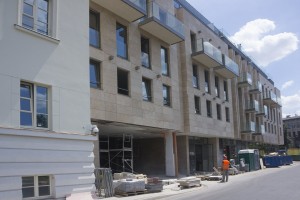Controversy
The four cases we have explored in the above modules by no means exhaust contemporary range of interventions in historic environments. We don’t want to suggest either that these four ‘Cs’ cover the typology of ‘correct’ interventions. Actually, they all may lead to highly controversial actions. Operating with sharp contrast may cut the historic fabric into pieces. Sticking to the principle of continuity may result in producing misleading replicas of things of the past. Conservation without allowing some fresh air will result in creating ‘cultural conserves’. And collage is often difficult to be distinguished from kitsch.
In this module we’d like to consider a controversial case of intervention in a historic environment. The purpose is to encourage you to think through some of the questions raised in the course of this development in order to realize the values which need to be taken into account in such cases. We’ve chosen a building located in the vicinity of the places presented above, in the dense historic setting of Kraków old town. It is an apartment building adapting and extending former nuns convent for housing and recreation purposes. At the time of gathering material for this module this was still a building site at the final stage of works as you can see in the photographs.
Before we proceed to a review of some of the issues raised by this project let’s restate the key principles which we’ve already discussed in the previous modules. Historic environments exhibit a range of heritage values – social, historical, architectural, aesthetic – and thus the quality of new insertions is of high importance. There is a wide agreement on what guidelines should be followed to ensure appropriateness of contemporary additions. Design professionals argue that although taste is subjective, design quality is measurable and thus some assessment criteria can and should be established. These criteria take into account the character of the historic setting in which a new object is planned, its size and form in relation to surrounding buildings and landscape, how it ‘sits’ in the area and what relation it bears to predominant building materials, textures, ranges of colour and decoration details.
The old part of the building was well embedded in its environment. Its architecture reflects many layers of Kraków’s history deeply rooted in Renaissance and creatively continued through neoclassicism to modernity. Now a new part has been attached directly to it. Magnify the pictures to better see a protruding wall of the new development. Consider how it impacts on the adjacent old building, how they align together. Does the new part convey a sense of continuity with the past? Does the new development maintain, enhance or diminish a sense of the place? Is it a sympathetic development?
Let’s look at the two parts from another perspective to better see how they ‘connect’ with each other. Alignment is an important factor in maintaining continuity of architectural forms. It’s one of the techniques to make a new insertion ‘sit’ comfortably in its surroundings. If there are too many discordant lines they underline discontinuity of the insertion. Another factor contributing to continuity of forms is the rhythm of their elements, e.g. windows, frontage patterns, ornamental details, etc. With the above considerations in view see how the two parts correspond to each other. Is the whole structure emerging from the extension project consistent and cohesive?
Now let’s see some developments in the interior. The building used to be a nuns convent with a historic octagon chapel, now under reconstruction into a spacious fancy apartment. The designers freely play with remaining elements of religious significance, e.g. the altar style decorated balcony set against a dense symbolic background painted by an art nouveau artist.
But aren’t we going too far in our explorations? This is an interior of a private apartment – the designers have the full right to follow the tastes of the owners, don’t they? Or should they rather first try to achieve some level of consensus and certainty with conservationists on what constitutes appropriate development in this historic place. Certainly, we get some more Cs to consider in order to understand the nature of the controversy that the investment generated in the local community.
The best way to come closer to understanding what can be considered an appropriate development in a historic setting is to first study concrete examples of such interventions. There are many projects which gained recognition, both in local communities and professional circles of designers. Then it is worth proceeding to controversial examples. They usually generate heated debates in which you will see how concrete assessment criteria are used in argumentation, what practical value they have. Accordingly, we’d like to close this module with two sets of examples.
Cases which gained recognition and wide approval
- Design in Context: case studies from Austria
- New Design in Historic Settings: case studies from Scotland
Controversial cases
First choose one case recognized as good practice and reconstruct arguments for such nomination. Then think why the above controversial cases met with strong opposition. You may have to further search the web for more information and views on these developments. You’ll easily find related sites as both the projects gained a wide response.




